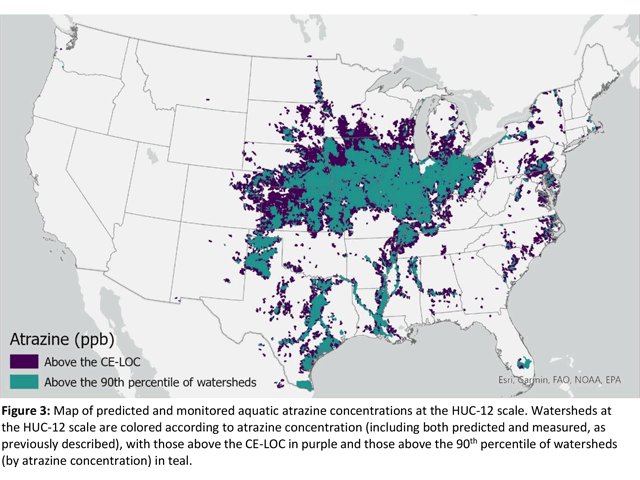Time Running Out to Comment on Atrazine
Farmers Encouraged to Share Their Thoughts on Future Use of Atrazine Herbicide
JEFFERSON CITY, Mo. (DTN) -- Farmers and other users of atrazine have only two days remaining to comment on the U.S. EPA'S proposed regulation changes for the herbicide. The deadline to submit comments is 11:59 p.m. EDT, Friday, Oct. 7.
As of Wednesday morning, nearly 11,000 comments had been received by the agency.
While many farmers might feel like they aren't qualified to speak to the science used to develop the regulations, they are encouraged to share their personal experiences with atrazine, said Mark VanGessel, a weed scientist at the University of Delaware who serves as the Weed Science Society of America's liaison to the EPA.
"As opposed to just saying, 'It's a valuable tool,' farmers can put some hard numbers to this decision," VanGessel said. "If you didn't have atrazine, or if your atrazine use was restricted, what would it mean to your operation? Would you need to replace it with another herbicide? Would that other herbicide be as effective? Would it change your application timings? Will it cost more? Those are the type of specifics they are looking for."
In June, EPA released proposed revisions to its September 2020 atrazine interim decision and opened a 60-day public comment period, which was later extended to 90 days. In order to decrease atrazine runoff from treated fields, the agency determined that additional mitigation was required and put forth the following proposed measures:
-- Prohibit atrazine application when soils are saturated or above field capacity (i.e., the soil's ability to hold water);
-- Prohibit application during rain or when a storm event, likely to produce runoff from the treated area, is forecast within 48 hours of application;
-- Prohibit aerial application of all formulations; and
P[L1] D[0x0] M[300x250] OOP[F] ADUNIT[] T[]
-- Restrict annual application rates to 2 pounds of active ingredient or less per acre per year when applying to sorghum, field corn and sweet corn.
In addition, EPA proposed the addition of a "picklist" requiring farmers to select a combination of rate reductions and/or runoff control measures to mitigate atrazine in watersheds where concentrations of the herbicide exceed the level of concern. These measures include conservation practices such as planting cover crops or the installation and maintenance of vegetative filter strips, grassed waterways, field borders or buffer strips.
In an e-mail to DTN, an EPA spokesperson wrote that the agency is encouraging public comments regarding the proposed picklist. In particular, EPA would like to receive comments on:
-- Suggested changes to the definitions of these measures to be more inclusive of differing agronomic practices;
-- Information on the effectiveness of individual mitigation measures at reducing runoff in real-world settings;
-- Suggestions for other practices that could be included on the picklist; or
-- Recent changes in agronomic practices or regional differences that could affect the adoption of a mitigation practice in some areas or for certain crops.
Farmers who have implemented practices in the past to keep soil in place for nutrient management and erosion control should share their experiences, VanGessel said.
"Hearing those comments would be great," he said. "Through my discussions with EPA, they're looking for practical suggestions to populate that picklist and make it as expansive as they can."
Commodity organizations such as the National Corn Growers Association and the National Sorghum Producers have organized campaigns encouraging their members to comment on the proposed regulation changes and offering a form letter that growers can personalize and submit.
According to a list of tips for effective comments on the EPA website, one well-supported comment is often more informative to the agency than a thousand form letters. It reminds citizens that the comment process is not a vote. The EPA also states that mass mail campaigns have special posting guidelines. In instances where individual submissions are deemed to be duplicate or near duplicate copies as part of a mass mail campaign, EPA will post to Regulations.gov one representative sample comment along with the total comment count for that campaign.
"I think the form letters have value in terms of just looking at the sheer number of people who have concerns, but having those personal experiences from an individual operation is going to be more meaningful," VanGessel said.
To comment on the proposed revisions to the atrazine interim decision, go to https://www.regulations.gov/….
Descriptions of the picklist mitigation measures can be found here: https://www.regulations.gov/….
Tips for commenting on EPA dockets can be found here: https://www.epa.gov/….
Jason Jenkins can be reached at jason.jenkins@dtn.com
Follow him on Twitter @JasonJenkinsDTN
(c) Copyright 2022 DTN, LLC. All rights reserved.






